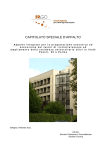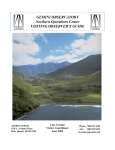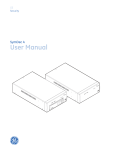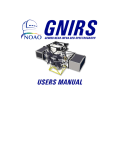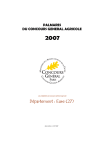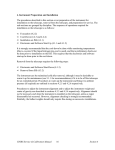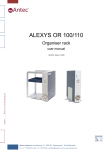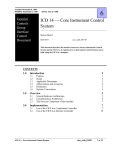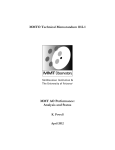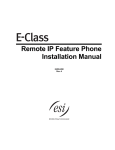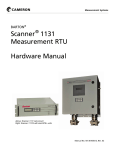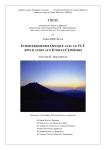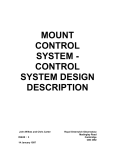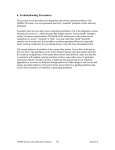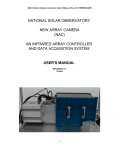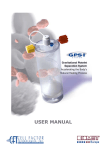Download "user manual"
Transcript
MCAO Gemini 8-m Telescope 670 N. A’Ohoku Place HILO HI-96720 MCAO Functional and Performance Requirements Document Prepared By: François Rigaut Contributors: Mark Chun, Brent Ellerbroek, Céline d’Orgeville and François Rigaut, Created February 14, 2000. Last Modified May 13, 2000. Date Approved By: Group Manager Group Manager (if req.) Systems Engineer MCAO MCAO Functional and Performance Requirements Document Page 2 of 24 07/11/01 MCAO MCAO Functional and Performance Requirements Document Revision Control Revision No. Author & Date Revision 1 F.Rigaut Approval & Date Description Original Document May 1, 2000 Page 3 of 24 07/11/01 MCAO MCAO Functional and Performance Requirements Document MCAO FUNCTIONAL AND PERFORMANCE REQUIREMENTS DOCUMENT ................................................................................ 1 1. PURPOSE OF THIS DOCUMENT ................................................................................................................. 6 2. APPLICABLE DOCUMENTS......................................................................................................................... 6 3. ACRONYMS .................................................................................................................................................... 7 4. OPERATIONAL CONDITIONS ..................................................................................................................... 7 4.1. 4.2. 4.3. 4.4. 5. ATMOSPHERIC CONDITIONS .......................................................................................................................... 7 WIND SHAKE ............................................................................................................................................... 7 SODIUM LAYER CONTENT ............................................................................................................................ 8 ENVIRONMENTAL CONDITIONS ..................................................................................................................... 8 “COMPLETE SYSTEM” REQUIREMENTS................................................................................................. 9 5.1. TOP-LEVEL SCIENCE REQUIREMENTS ........................................................................................................... 9 5.1.1. Wavelength Coverage .......................................................................................................................... 9 5.1.2. Throughput.......................................................................................................................................... 9 5.1.3. Emissivity ............................................................................................................................................ 9 5.1.4. Flat Fielding ....................................................................................................................................... 9 5.1.5. Strehl Ratio ......................................................................................................................................... 9 5.1.6. Seeing limit for operation................................................................................................................... 10 5.1.7. Transferred Field of view................................................................................................................... 10 5.1.8. PSF uniformity and field of view ........................................................................................................ 10 5.1.9. Sky Coverage..................................................................................................................................... 10 5.1.10. Ability to Dither................................................................................................................................. 10 5.1.11. Zenith Angle ...................................................................................................................................... 10 5.1.12. F/30 output........................................................................................................................................ 10 5.1.13. Atmospheric Dispersion Compensator ............................................................................................... 10 5.1.14. PSF estimation .................................................................................................................................. 10 5.1.15. Diagnostics ....................................................................................................................................... 11 5.1.16. Astrometric accuracy / Field distortion .............................................................................................. 11 5.1.17. Number of NGS ................................................................................................................................. 11 5.1.18. Ghosts images ................................................................................................................................... 11 5.1.19. Scattered light level ........................................................................................................................... 11 5.2. MECHANICAL REQUIREMENTS .................................................................................................................... 11 5.2.1. Safety ................................................................................................................................................ 11 5.2.2. Time to function................................................................................................................................. 11 5.2.3. Thermal tolerance: ............................................................................................................................ 11 5.2.4. Metric dimensioning .......................................................................................................................... 11 5.2.5. Metric dimensions on drawings.......................................................................................................... 11 5.2.6. Metric fasteners................................................................................................................................. 12 5.3. CONTROL SYSTEM REQUIREMENTS ............................................................................................................. 12 5.3.1. Operability ........................................................................................................................................ 12 5.3.2. Configuration time............................................................................................................................. 12 5.3.3. Impact on mechanism accuracy ......................................................................................................... 12 5.3.4. Impact on scientific performance ....................................................................................................... 12 5.3.5. Temperature control .......................................................................................................................... 12 5.4. ELECTRICAL AND ELECTRONIC REQUIREMENTS ........................................................................................... 12 5.4.1. Grounding and shielding ................................................................................................................... 12 5.4.2. Electrostatic discharge ...................................................................................................................... 13 Page 4 of 24 07/11/01 MCAO MCAO Functional and Performance Requirements Document 5.4.3. Power Consumption........................................................................................................................... 13 5.5. ENVIRONMENTAL REQUIREMENTS .............................................................................................................. 13 5.5.1. Altitude requirements......................................................................................................................... 13 5.5.2. Temperature environment .................................................................................................................. 13 5.5.3. Humidity environment........................................................................................................................ 14 5.5.4. Mechanical environment.................................................................................................................... 14 5.6. SOFTWARE REQUIREMENTS ........................................................................................................................ 14 5.6.1. Software design requirements ............................................................................................................ 14 5.6.2. EPICS compatibility .......................................................................................................................... 14 5.6.3. Engineering Interface ........................................................................................................................ 14 5.7. OTHER REQUIREMENTS .............................................................................................................................. 15 5.7.1. Documentation .................................................................................................................................. 15 5.7.2. Reliability.......................................................................................................................................... 15 5.7.3. Maintainability and serviceability...................................................................................................... 16 5.7.4. Lifetime and reliability....................................................................................................................... 16 5.7.5. Safety ................................................................................................................................................ 17 6. ADAPTIVE OPTICS MODULE.................................................................................................................... 17 6.1. PERFORMANCE REQUIREMENTS .................................................................................................................. 17 6.1.1. Optical requirements ......................................................................................................................... 17 6.1.2. Mechanical requirements................................................................................................................... 18 6.1.3. Space Requirements........................................................................................................................... 19 6.1.4. Mass and center of gravity requirements............................................................................................ 19 6.1.5. Electrical and electronic requirements............................................................................................... 20 6.2. SOFTWARE REQUIREMENTS ........................................................................................................................ 20 6.2.1. Data processing and data storage ...................................................................................................... 20 7. LASER SYSTEM AND LASER CONTROL SYSTEM ................................................................................ 20 7.1. PERFORMANCE REQUIREMENTS .................................................................................................................. 20 7.2. FUNCTIONAL REQUIREMENTS ..................................................................................................................... 21 7.2.1. Laser System location ........................................................................................................................ 21 7.2.2. Electrical and electronic requirements............................................................................................... 21 7.2.3. Laser System Control System ............................................................................................................. 21 8. LASER LAUNCH TELESCOPE AND BEAM TRANSFER OPTICS ......................................................... 22 8.1. PERFORMANCE REQUIREMENTS .................................................................................................................. 22 8.1.1. Blind Pointing accuracy..................................................................................................................... 22 8.1.2. Jittering............................................................................................................................................. 22 8.1.3. BTO + LLT Optical quality................................................................................................................ 22 8.2. FUNCTIONAL REQUIREMENTS ..................................................................................................................... 22 8.2.1. LLT requirements .............................................................................................................................. 22 8.2.2. BTO requirements ............................................................................................................................. 23 8.2.3. Electrical and electronic requirements............................................................................................... 23 8.2.4. Maintenance requirements................................................................................................................. 23 8.2.5. Light scattering ................................................................................................................................. 23 9. SALSA............................................................................................................................................................. 23 9.1. 9.2. 10. PERFORMANCE REQUIREMENTS .................................................................................................................. 23 FUNCTIONAL REQUIREMENTS ..................................................................................................................... 23 MCAO STREHL RATIO BUDGET .......................................................................................................... 24 Page 5 of 24 07/11/01 MCAO MCAO Functional and Performance Requirements Document 1. Purpose of this document This document, the Functional and Performance Requirement Document (FPRD) defines first the scientific requirement of the Gemini Multi-Conjugate Adaptive Optics (MCAO). These requirements, coupled with the system operational concepts detailed in the Operational Concept Definition Document (OCDD) are translated in the current document into technical and functional requirements. The purpose of the MCAO FPRD is to provide engineers with the requirements on which to base the MCAO design. It also provides guideline for the future users to understand better the functionalities of the system, what it will do, and how well and how fast it will do it. The design is derived from this document. This document takes precedence over other design and fabrication documents. The design must serve the requirements in this document completely. Every feature of the MCAO should be traceable to a requirement in this document, and there should be no features of MCAO that are not required by this document. The MCAO will be designed in stages, with a review after each stage is complete. Comments from the review committee will be folded into the design, so the requirements will change as the design changes. Therefore, this document will be upgraded as needed after each major design review to maintain the correspondence between design and requirements. This FPRD is largely inspired from the FPRD of Altair and NIFS. 2. Applicable Documents Document ID Source Title SPE-S-G0041 Gemini Gemini System Error Budget Plan RPT-AO-G0091 Gemini Feasibility Study for A Multi-Conjugate Adaptive Optics system for Gemini South Gemini MCAO OCDD Page 6 of 24 07/11/01 MCAO MCAO Functional and Performance Requirements Document 3. Acronyms AOM Adaptive Optics Module BTO Beam Transfer Optics GS Guide Star ICD Interface Control Document ICS Instrument Controller Software [package] LCS Laser Control System LGS Laser Guide Star LLT Laser Launch Telescope LS Laser System LS CS Laser System Control System MCAO Multi-Conjugate Adaptive Optics NGS Natural Guide Star OCDD Operational Concept Definition Document PSF Point Spread Function SALSA Safe Aircraft Localization and Satellite Acquisition system TT Tip-Tilt 4. Operational Conditions 4.1. Atmospheric conditions The guidelines for the MCAO system performance assume a standard set of conditions. This includes the atmospheric conditions, the telescope performance, and the optical aberrations in the science instrument. This section outlines the nominal conditions for these components. Median atmospheric conditions are assumed. These conditions are summarized in the following table. Median Conditions ro @ 0.55 µm θo @ 0.55 µm Lo @ 0.55 µm τ0 16.5 cm 2.2’’ 36 m 5 ms 4.2. Wind Shake For median wind conditions (8.4 m/s wind speed) at right angles to the enclosure slit, the telescope wind shake power spectrum is assumed to be as follows (McGonegal in Altair OCDD, Morris, Herriot, and Davidge 1997). For f < 6.4 Hz P = 1.876e-14 * 0.3401 rad2/Hz For f > 6.4 Hz P = 1.876e-14 * 0.3401 * (f/6.4)(-8) rad2/Hz Page 7 of 24 07/11/01 MCAO MCAO Functional and Performance Requirements Document 4.3. Sodium Layer Content The figure below gives an example of sodium layer content over the year. It was measured at 40 degrees North latitude. The minimum is reached early in summer (May-June) for values around 2 109 atoms/cm2. 4.4. Environmental conditions The temperature in the dome will vary between –10 and 20 degrees Celsius. Page 8 of 24 07/11/01 MCAO MCAO Functional and Performance Requirements Document 5. “Complete System” Requirements This section lists the top-level science requirements, the performance requirements and the functional requirements for the complete MCAO system. The latter includes: • The AO Module: Module mounted to the ISS and including the AO compensation system as such. It acts as an interface between the telescope and the instruments. It contains the re-imaging optics, deformable mirrors, LGS and NGS sensors. By extension, this also includes all the electronics and control systems. • The laser system and laser control system: This is the laser(s) itself and its control system • The beam transfer optics and laser launch telescope: Optical relay from the laser system to the top of the secondary. The LLT is the last part, which expand the beam to a larger diameter and assures beam pointing. This includes the BTO and LLT control systems • SALSA: This is the safety system which primary function is to detect approaching aircraft. Its only connection to the AO system is a broadcast signal, which interrupt the laser propagation. The requirements listed in this section apply either to the whole system or to each subsystem. 5.1. Top-Level Science Requirements 5.1.1. Wavelength Coverage REQ-FPR-0001: MCAO will pass the 1-2.5µm wavelength range to the instrument. It will be possible to also pass the 0.8-1.0 micron range, with requirement of a changeable dichroic. A goal is to extend observations to 5µm and not preclude use to 0.5µm. 5.1.2. Throughput REQ-FPR-0002: The deployment of AO will not lower the telescope throughput by more than an average of 25% over the baseline wavelength range. At no wavelength it should be more than 30%. With a changeable dichroic the same throughput specification is required for 0.85 - 1.0µm. 5.1.3. Emissivity REQ-FPR-0003: The total emissivity of the telescope and AO system (without atmospheric dispersion compensation) in K must be <19%, with a goal of this emissivity out to 5µm. 5.1.4. Flat Fielding REQ-FPR-0004: It is required that the flat field instability does not cause systematic effects larger than the photon noise over a 5x5 arcsec2 region within a one-hour integration in J through K, narrow and wide bandpasses. It is a goal to match this in L and M. 5.1.5. Strehl Ratio REQ-FPR-0005: The MCAO system will deliver a minimum AO-only average H band Strehl ratio of 0.54 over the central one arcmin square of the compensated field of view. This specification will be reached for any period of time of 15 minutes, during median seeing conditions, at or about zenith, at the output of the MCAO system, excluding telescope and instrument aberrations, but including compensation of the wind shake and the MCAO system calibration errors. This assumes the use of bright natural guide stars for the compensation of the low order terms. The system is expected to deliver a commensurate performance at any wavelength of operation (0.34 at J, 0.71 at K) Page 9 of 24 07/11/01 MCAO MCAO Functional and Performance Requirements Document 5.1.6. Seeing limit for operation REQ-FPR-0006: The system will be able to work under a variety of turbulence conditions. In particular, it should give commensurate performance to the one specified above for seeing values up to 1.2 arcsec. 5.1.7. Transferred Field of view REQ-FPR-0007: The MCAO system will transfer a circular unvignetted field of view of 2 arcmin in diameter to the instruments. 5.1.8. PSF uniformity and field of view REQ-FPR-0008: The Strehl ratio uniformity will be better than 4% rms in H band in the central one square arcmin over which the Strehl ratio specification REQ-FPR-0005 is given. In addition to the Strehl uniformity over the central one arcmin square, the Strehl should be maximized everywhere in the field. 5.1.9. Sky Coverage REQ-FPR-0009: The sky coverage will be maximized for the specified Strehl ratios. A minimum value of 10% at the galactic pole should be reached with a Strehl degradation of no more than 50% of the value specified in REQ-FPR0005, in H band. LGS should be used, and sensing of the tip-tilt and low order modes on the NGS should be optimized. This specification applies when using the primary mode of observation (all the visible light up to 0.95 micron is used for the TT sensing). 5.1.10. Ability to Dither REQ-FPR-0010: It must be possible to execute a dithering sequence with the AO system and a scientific instrument, moving the science field on the science detector by several arcseconds. 5.1.11. Zenith Angle REQ-FPR-0011: The Strehl ratio specifications for the system are set at Zenith. The system will be routinely operated at Zenith angles up to 60 degrees, and in this range, the system performance should be commensurate to the performance specified at Zenith. 5.1.12. F/30 output REQ-FPR-0012: The output F ratio of the AO module will be F/30. The telescope focal plane and pupil distance will be preserved. 5.1.13. Atmospheric Dispersion Compensator REQ-FPR-0013: The MCAO system will have its own science path atmospheric dispersion compensator, covering the 0.80-2.5 microns domain over the 2 arcmin diameter field of view. The residual atmospheric dispersion in any of the wide Near IR band will not reduce the Strehl ratio by more than 2%. 5.1.14. PSF estimation REQ-FPR-0014: The system should have a PSF estimator (PSF in function of the field position) that delivers a PSF with 2% accuracy on the Strehl value. This PSF estimator should include the effects of the atmosphere, telescope, MCAO system, and ADC. It is strongly desirable that this PSF estimator also includes the effect of the instrument. This set of PSFs shall be saved in a coordinated manner with the science instrument data. Page 10 of 24 07/11/01 MCAO MCAO Functional and Performance Requirements Document 5.1.15. Diagnostics REQ-FPR-0015: There will be real time and logged information about r 0, τ0, L0 and θ0.These values shall be saved together with the instrument data. Accuracy of 10% is required on r0, 20% on τ0, L0 and θ0. 5.1.16. Astrometric accuracy / Field distortion REQ-FPR-0016: The MCAO system shall not introduce static or quasi-static plate scale changes of more than 30 parts in a million (e.g. 3 milliarcsec over 100 arcsec), in addition to the fixed field distortion induced by the optics that can be calibrated. 5.1.17. Number of NGS REQ-FPR-0017: Although the above specifications of the MCAO system are stated when using 3 natural guide stars to correct the low order modes, it is a requirement that the system may work, with reduced performance, with two or one natural guide stars. 5.1.18. Ghosts images REQ-FPR-0018: Ghost images generated in the MCAO optics must be at a level below 10-4 from the parent image. They should be characterized and predictable. 5.1.19. Scattered light level REQ-FPR-0019: The total amount of light scattered by the MCAO optics should be < 2% (goal 1%) of the light entering the AOM. 5.2. Mechanical requirements 5.2.1. Safety REQ-FPR-0101: No mechanisms will move in the event of loss of electrical power. 5.2.2. Time to function REQ-FPR-0102: Individual MCAO mechanisms should be set within 30s and a complete mechanical reconfiguration of the instrument should be achieved in < 1 min. 5.2.3. Thermal tolerance: REQ-FPR-0103: The optical benches should be thermally stable enough so that the need for recalibration is not driven by the opto-mechanical bench but by other elements like e.g. deformable mirrors. 5.2.4. Metric dimensioning REQ-FPR-0104: Metric dimensions will be used in the MCAO system. 5.2.5. Metric dimensions on drawings REQ-FPR-0105: Metric dimensions in millimeters will be used in all as-built drawings, with dimensions called out to 0.01mm. Page 11 of 24 07/11/01 MCAO MCAO Functional and Performance Requirements Document 5.2.6. Metric fasteners REQ-FPR-0106: All screws, bolt, nuts, tapped holes, and fasteners will be of standard metric size, and called out as such on the as-built drawings. 5.3. Control system requirements 5.3.1. Operability REQ-FPR-0201: All MCAO motions, e.g. NGS probes, science path ADC, NGS ADC(s), LLT deployment, Laser shutters Laser functionality, AO control loop operations, and other controllable features of MCAO will be controllable by computer through the standard EPICS control paths from the Instrument Control System. 5.3.2. Configuration time REQ-FPR-0202: The configuration times for various operations are listed below: Table 1. Operational overhead specifications Task Maximum Overhead REQ-FPR-0202a Day time prep operations 1 hour REQ-FPR-0202b Night time overall set up 10 min REQ-FPR-0202c Object set up (excludes telescope slewing and acquisition of TCS guide stars but includes TT probe arm positioning for minimum astrometric requirements) 2 min REQ-FPR-0202d Dithering 5.3.3. 3s Impact on mechanism accuracy REQ-FPR-0203: The control system for MCAO will be designed so that the accuracy of the controllable mechanisms is not limited by the performance of the control system. 5.3.4. Impact on scientific performance REQ-FPR-0204: The control system will not impact on the scientific performance of the MCAO system. 5.3.5. Temperature control DM temperatures monitored as needed for DM calibration. Laser system temperature controlled as needed for wavelength stability and beam quality. 5.4. Electrical and electronic requirements REQ-FPR-0301: The MCAO system has to be designed in accordance with modern electronics engineering practice for astronomical applications. 5.4.1. Grounding and shielding REQ-FPR-0302: Separate ground returns shall be provided for low-level signals, noisy components such as relays and motors, and hardware components such as mechanical enclosures, chassis, and racks. Page 12 of 24 07/11/01 MCAO MCAO Functional and Performance Requirements Document 5.4.2. Electrostatic discharge REQ-FPR-0303: The MCAO design will protect sensitive components from electrostatic discharge. 5.4.3. Power Consumption REQ-FPR-0304: The total power used by the MCAO system should not be more than TBD W. This splits into the various subsystems as follow: Table 2. Subsystems power consumption specifications Subsystem Power consumption REQ-FPR-0304a AOM TBD W REQ-FPR-0304b LS + LCS 190kW (3 phase 208 VAC, 30 Amps max) REQ-FPR-0304c BTO + LLT TBD W REQ-FPR-0304d SALSA TBD W 5.5. Environmental requirements 5.5.1. 5.5.1.1. Altitude requirements Operation altitudes: REQ-FPR-0401: The MCAO system will be capable of being operated at any altitude between sea level and the Mauna Kea summit altitude. 5.5.1.2. Storage altitude: REQ-FPR-0402: The MCAO system will be capable of being stored in or out of its shipping container at any altitude between sea level and the Mauna Kea summit altitude. 5.5.1.3. Transportation altitude: REQ-FPR-0403: The MCAO system will be capable of being transported at any altitude between sea level and the altitude of the Mauna Kea summit by any transportation mode. It will be capable of being transported by commercial jet with pressurized cargo compartments at altitude up to 15 km. 5.5.2. 5.5.2.1. Temperature environment Operational temperature: REQ-FPR-0404: The MCAO operational environment will be limited to –15 to +25 C. 5.5.2.2. Survival Temperature: REQ-FPR-0405: The MCAO system will be capable of surviving a temperature range of –20 to +50 C without damage. 5.5.2.3. Transport temperature: REQ-FPR-0406: The MCAO system will be capable of withstanding a temperature range of –20 to +50 C during transport without damage. Page 13 of 24 07/11/01 MCAO MCAO Functional and Performance Requirements Document 5.5.3. 5.5.3.1. Humidity environment Operation: REQ-FPR-0407: The MCAO system will be capable of being operated at altitude from sea level to the summit of Mauna Kea in the range of 0 to 90% relative humidity, without damage. 5.5.3.2. Transportation: REQ-FPR-0408: The MCAO system will be capable of being transported and stored in a wide range of altitude and temperature environments in the range of 0 to 100% relative humidity, with condensing moisture. 5.5.4. 5.5.4.1. Mechanical environment Telescope slew rate: REQ-FPR-0409: The MCAO system will be capable of withstanding slew rates of 2 degrees per second in azimuth and 0.75 degree per second in elevation, or any combination of these along with rotation of the Cassegrain rotator to maintain alignment with the parallactic angle as it changes at these slew rates. All optics and mechanisms will meet their specifications at these rates. 5.6. Software requirements 5.6.1. Software design requirements REQ-FPR-0501: The MCAO will be a “conforming” instrument, in that it will use EPICS and conform to the Geminisoftware and control system standards and the requirements listed below. 5.6.1.1. Use of EPICS REQ-FPR-0502: The MCAO system will use a standard Gemini configuration of a workstation for the operator interface to an EPICS based system used for controlling motors, and for receiving status information from sensors. 5.6.1.2. EPICS system REQ-FPR-0503: The EPICS system will be a standard Gemini Unit (VME crate, MPC750 CPU, VxWorks operating system). 5.6.2. 5.6.2.1. EPICS compatibility Interfaces to the Gemini system REQ-FPR-0504: Interfaces to the Gemini system will conform to the descriptions presented in the core ICS documentation. Interfaces to other Gemini subsystems will conform to the relevant ICD. 5.6.3. Engineering Interface REQ-FPR-0505: The MCAO system will provide a means for command and control of the MCAO mechanisms, detector controllers and real-time computer without the need for having the Gemini control systems (i.e. the OCS, TCS, etc.) present or connected. 5.6.3.1. Physical interface REQ-FPR-0506: The Engineering interface will use a Sun/Solaris workstation of the same type as that used for the instrument control system that runs with other Gemini control systems. Page 14 of 24 07/11/01 MCAO MCAO Functional and Performance Requirements Document 5.6.3.2. User Interface REQ-FPR-0507: To the extent practicable, the user interface in the engineering interface should appear to a user to be similar to the Gemini observing tool, although it will be at much lower level. 5.6.3.3. Command and control REQ-FPR-0508: The engineering interface will be capable of commanding and controlling all MCAO mechanisms, doing all necessary and low level operations with the real time computer, reading data from the various sensors and detectors, reading status from all sensors. 5.6.3.4. Data capture REQ-FPR-0509: The engineering interface will be capable of capturing the data from the MCAO system. 5.7. Other requirements 5.7.1. Documentation REQ-FPR-0601: The MCAO system will be delivered with adequate documentation to facilitate its operation, maintenance and repair. 5.7.1.1. User’s Manual: REQ-FPR-0602: The user’s manual shall be written to enable a new user to get easily acquainted with its operation. 5.7.1.2. Service and calibration manuals: REQ-FPR-0603: A manual will be written to enable Gemini technical support personnel to maintain the MCAO system. This manual will include documentation to describe the calibration required to optimize the operation of the system at the specification level. 5.7.1.3. Software maintenance manual: REQ-FPR-0604: A software maintenance manual will be provided to enable Gemini software maintenance staff to maintain the MCAO software. 5.7.1.4. As-built drawings: REQ-FPR-0605: The as-built drawings will show all the dimensions in millimeters, down to 0.01 mm. All fasteners specified in these drawings will be standard metric sizes. All drawings shall otherwise be to RSAA standards used in instruments of similar size, function, and complexity. 5.7.1.5. Drawing standards: REQ-FPR-0606: All drawings will comply with US standard or a Gemini approved standard 5.7.2. Reliability REQ-FPR-0607: The MCAO system will be designed and build to be reliable 5.7.2.1. Downtime: REQ-FPR-0608: The MCAO system will have a downtime of < 10% schedule time on the telescope and where possible, component failure will result in gradual performance degradation. Page 15 of 24 07/11/01 MCAO MCAO Functional and Performance Requirements Document 5.7.2.2. Spares: REQ-FPR-0609: Single point failure that may result in significant downtime will be determined and, where necessary, critical spares will be identified. 5.7.2.3. Continuous duty: REQ-FPR-0610: The MCAO system will be designed and built for continuous operation. Modules containing moving parts, e.g. Natural guide stars probes, Laser guide stars focusing mechanisms, ADCs, will be designed or selected to meet requirements on downtime assuming continuous operation. 5.7.3. Maintainability and serviceability REQ-FPR-0611: The MCAO system shall meet the Gemini requirements for maintainability. 5.7.3.1. Standard components: REQ-FPR-0612: Wherever possible, the MCAO will use unmodified commercially available standard components. 5.7.3.2. Modularity REQ-FPR-0613: To the extent possible, the MCAO will be designed to be modular. 5.7.3.3. Access REQ-FPR-0614: Access to the components and subassemblies will be considered in the MCAO design, particularly for those elements that are accessed frequently. Tool and hand clearances will be considered, as well as space required to move the modules, visual access to components (or a means to feel their correct position and alignment). 5.7.3.4. Alignment REQ-FPR-0615: Alignment of optical components will be achieved to the extent possible by accurate machining of locating fixtures. 5.7.3.5. Relative equipment arrangements REQ-FPR-0616: Equipment will be located with due consideration of the sequence of operations involved in maintenance procedures. To the extent possible, the most accessible locations will be reserved for the items requiring most frequent access. 5.7.3.6. Subassemblies REQ-FPR-0617: Subassemblies of the equipment that require more frequent service (inspection, adjustment, repair, or replacement) will be configured as plug-in modules or, if in racks, as drawers that can be withdrawn easily. 5.7.3.7. Handling REQ-FPR-0618: Modules greater than 20 kg in mass will have suitable handles for use in removing, replacing, and carrying them. Handles will be located such that the vector sum of resultant handling forces will pass close to the center of gravity of the unit. 5.7.3.8. Revisability REQ-FPR-0619: Multilayer electronics board will not be used unless they are replaceable as a module. 5.7.4. Lifetime and reliability REQ-FPR-0620: The MCAO system will be designed for an operational lifetime of 10 years without a major overhaul. Components likely to affect the lifetime requirement will be identified. Page 16 of 24 07/11/01 MCAO MCAO Functional and Performance Requirements Document As per the Gemini Reliability and Maintainability Plan v.1 June 10, 1994, every work package delivered to Gemini will include a preventive maintenance program. This will include specification of the off-line and scheduled maintenance as well as a suggested spare parts list. Table 3. System Reliability Specifications Component Mean Time Between Failures Mean Time to Repair Complete System REQ-FPR-0621a > 80 24 h AO module REQ-FPR-0621b > 1600 12 h LS + LCS minor fail. REQ-FPR-0621c > 100 12 h LS + LCS major fail. REQ-FPR-0621d > 900 1 week BTO + LLT REQ-FPR-0621e > 2400 24 h SALSA REQ-FPR-0621f > 3200 48 h REQ-FPR-0622: The LGS facility will be available for use no less than 1800 night-time hours per year. This is everyother night, or six months of night-time use per year. 5.7.5. Safety REQ-FPR-0623: Normal considerations, including compliance with applicable regulations will apply in the area of mechanical, electrical, electrostatic and laser safety. 6. Adaptive Optics Module 6.1. Performance Requirements 6.1.1. 6.1.1.1. Optical requirements Optical Quality: REQ-FPR-0701: The Strehl ratio of a static image at the output focal plan of the AOM should be better than 95% at 1.6 microns over the entire 2 arcmin field and at any point in this field. The performance should be commensurate at any wavelength from 1 to 2.5 microns (91% at 1.25 microns and 97% at 2.2 microns). REQ-FPR-0702: The output focal plan should be flat within the above specifications. REQ-FPR-0703: Strehl variations within these specifications are acceptable if they are fixed and can be calibrated. 6.1.1.2. Static PSF calibration REQ-FPR-0704: The AO Module will provide artificial sources at the input focal plane to calibrate the static and/or dynamic AO module + instrument fixed optical aberrations. REQ-FPR-0705: This or these artificial sources will be diffraction limited at any wavelengths above one microns (i.e. FWHM < 5 mas). 6.1.1.3. F/30 output: See REQ-FPR-0012. Page 17 of 24 07/11/01 MCAO MCAO Functional and Performance Requirements Document 6.1.1.4. Pupil location: REQ-FPR-0706: The pupil image location should be preserved by the AOM. The intent is that the instrument background should not be increased by 0.5% TBC by this effect. 6.1.1.5. Throughput: See REQ-FPR-0002. This requirement should be met over extended period of time. 6.1.1.6. Emissivity: See REQ-FPR-0003. This requirement should be met over extended period of time. 6.1.1.7. Field Distortion: REQ-FPR-0707: The fixed field distortion induced by the optical relay will not be greater than 2% TBC anywhere in the field. See REQ-FPR-0016 for time-variable field distortions. 6.1.1.8. Atmospheric dispersion compensation: See REQ-FPR-0013. 6.1.1.9. Natural guide star path ADC: REQ-FPR-0708: Each NGS beam will be compensated for atmospheric dispersion down to a residual spectral dispersion of 0.05’’ FWHM. 6.1.1.10. LGS path mirror and lens coatings: REQ-FPR-0709: Special optimized coating will be used in this path to optimize the transmission. 6.1.1.11. LGS light in NGS path REQ-FPR-0710: A notch filter of equivalent should be used to cut down the LGS stray light to < 30% of the night sky background. 6.1.1.12. Nitrogen flow / over pressure To maximize the length of time over which the throughput and emissivity requirement is met, it is advised that the interior of the AO module be kept under a slight overpressure, using Nitrogen. 6.1.2. Mechanical requirements 6.1.2.1. Flexures / image motion: REQ-FPR-0711: The OIWFS will compensate for the image motion induced by flexures. However, these flexures should be kept in a reasonable range. The image motion induced by flexure in the output F/30 focal plane should be smaller that 2 arcsec equivalent on the sky for a motion from zenith to 45 degrees zenith angle. 6.1.2.2. Position accuracy of the NGS probe positioning system REQ-FPR-0712: The NGS probes will be able to be positioned at better than 0.02” equivalent on the sky. The additional offsets to meet requirement REQ-FPR-0016 will be electronic offsets in the NGS control loop. 6.1.2.3. Position repeatability of the NGS probes REQ-FPR-0713: The NGS probes will be able to position themselves at a known/previously used position with an error < 0.01”. Page 18 of 24 07/11/01 MCAO MCAO Functional and Performance Requirements Document 6.1.2.4. Flexures / Strehl: REQ-FPR-0714: The Strehl ratio budget must be met at zenith angle from 0 to 60 degrees (REQ-FPR-0005). The flexure-induced Strehl ratio loss should be smaller than 2% at H band, and commensurate at the other wavelengths. 6.1.3. Space Requirements REQ-FPR-0715: The AOM will be designed to fulfill the space requirements for an instrument attached to the ISS 6.1.3.1. Electronics enclosure REQ-FPR-0716: All AOM electronics enclosures mounted on the ISS will be counted in the space requirements as above. Exception is the deformable mirrors HV power supplies (TBD). 6.1.3.2. Access to electronic enclosures REQ-FPR-0717: The electronic enclosures will be accessible without removing the AOM from the ISS. 6.1.3.3. Access to cooling water ports REQ-FPR-0718: Cooling water ports on the AOM will be accessible without removing the instrument from the ISS. 6.1.3.4. Access to dry air ports REQ-FPR-0719: Dry air ports on the AOM will be accessible without removing the instrument from the ISS. 6.1.3.5. Mechanical connections REQ-FPR-0720: All mechanical connection on the AOM will be accessible without removing the instrument from the ISS and while mounted with other instruments. 6.1.4. 6.1.4.1. Mass and center of gravity requirements Total mass REQ-FPR-0721: The AOM, including its support frame, thermal enclosures electronics and all cabling and services connections, will have a mass of 2000 kg. 6.1.4.2. Center of gravity REQ-FPR-0722: The AOM, including its support frame, thermal enclosures electronics and all cabling and services connections, will have a center of gravity on the port axis 1000mm from the mechanical interface on the ISS. 6.1.4.3. Balance tolerance REQ-FPR-0723: In any orientation of the telescope and rotator, the imbalance caused by the AOM must not exceed 400Nm with respect to the telescope elevation axis. This will include static imbalance and any change in mass moment due to moving elements. 6.1.4.4. Ballast weight REQ-FPR-0724: A ballast weight and its supporting structure will be supplied as required to meet the above requirements. 6.1.4.5. Instrument handling REQ-FPR-0725: The AO module support frame will have feet allowing the instrument to be stored free-standing, and attachment points for the Gemini instrument handling facilities. Page 19 of 24 07/11/01 MCAO MCAO Functional and Performance Requirements Document 6.1.5. 6.1.5.1. Electrical and electronic requirements Power dissipation REQ-FPR-0726: The AOM will be designed so that the total heat released to the Gemini dome air does not exceed 50W. REQ-FPR-0727: The heat conducted into the ISS structure will not exceed 50W. REQ-FPR-0728: Individual elements exposed to the air volume will not attain a temperature 2 degrees C above ambient. 6.1.5.2. Cassegrain cable wrap interface REQ-FPR-0729: All the connections from the AO module to the rest of the building will be through the cassegrain cable wrap. 6.2. Software Requirements 6.2.1. 6.2.1.1. Data processing and data storage Circular buffers REQ-FPR-0730: The AOM CS will be capable of storing up to 30 seconds of consecutive data, including wavefront measurements, deformable mirror commands, mirror modes and real-time loop status. 6.2.1.2. PSF estimation REQ-FPR-0731: The AOM CS will compute, synchronized by an outside signal, the necessary statistics to allow semi-real time PSF reconstruction. This will take into account wavefront measurements, deformable mirror commands over the period of integration of the scientific instrument, i.e. 30 seconds to several minutes. See REQ-FPR-0014. 6.2.1.3. Real time atmospheric parameter estimation REQ-FPR-0732: The AOM CS will provide real time estimation of r 0, τ0, L0, θ0 and the Cn2 profile.These values shall be saved together with the instrument data. Accuracy of 10% is required on r0, 20% on τ0, L0 and θ0. Best effort on the Cn2 profile. These estimations will be available while the loop is closed and when it is open. This Cn2 profile will be used to optimize the AO reconstructor if needed. See REQ-FPR-0015. 7. Laser System and Laser Control System 7.1. Performance Requirements Table 4. Performance and Performance Stability of Laser System Quantity Requirement 1 hour dev. at night 24-hour deviation (measured at output of LLT) Power (Watts) REQ-FPR-0801 5x7.2W eq. CW <1W per beam <1W per beam Beam Quality [xDL] REQ-FPR-0802 <1.5 <0.1 <0.1 Wavelength REQ-FPR-0803 589 nm (peak of sodium D2 line) <100MHz <100MHz Page 20 of 24 07/11/01 MCAO MCAO Functional and Performance Requirements Document sodium D2 line) Polarization REQ-FPR-0804 circular <10% <10% 7.2. Functional Requirements 7.2.1. Laser System location REQ-FPR-0805: The Laser System (or the last stage of the LS) is mounted on the telescope center section. This is a goal and not a requirement. 7.2.2. 7.2.2.1. Electrical and electronic requirements Power Dissipation REQ-FPR-0806: The LS will be designed so that the total heat released to the Gemini dome air does not exceed 50W. REQ-FPR-0807: The heat conducted into the telescope structure will not exceed 50W. REQ-FPR-0808: Individual elements exposed to the air volume will not attain a temperature of 2 degrees C above ambient. 7.2.2.2. Power consumption REQ-FPR-0809: The LS power consumption will be lower than 190 kW (3 phases 208 VAC, 30 Amps max). 7.2.2.3. Cooling REQ-FPR-0810: The maximum amount of heat that can be carried away from the Laser System is 5 kW. 7.2.3. Laser System Control System REQ-FPR-0811: The Laser System has its own Control System (CS) made of hardware and related software. The LS CS must be able to control the LS remotely. All LS controls, commands and signals must be accessible from the CP control room. 7.2.3.1. LS CS functionalities REQ-FPR-0812: The LS CS must interface with the MCAO Control System, and provide the following elementary tasks and sequences: REQ-FPR-0812a: Prior-to-start internal check REQ-FPR-0812b: Automated start-up REQ-FPR-0812c: Automated shutdown REQ-FPR-0812d: Emergency shutdown REQ-FPR-0813: If pulsed at a repetition rate close to 800 Hz, the LS shot to shot pulses must be controllable from an external signal. 7.2.3.2. LS diagnostics REQ-FPR-0814: The LS has suitable diagnostics to produce and maintain the sodium light. The following parameters are monitored in real time from the control room: output power, near-field and far-field spatial profiles, temporal profile (if the laser is pulsed), spectral profile. Page 21 of 24 07/11/01 MCAO MCAO Functional and Performance Requirements Document REQ-FPR-0815: The following parameters are monitored as well: LS internal status, temperature in the laser enclosure, coolant temperature and flow rate, accumulated hours. REQ-FPR-0816: All status information and relevant diagnostics parameters are logged for maintenance and debugging purposes. All information is time-stamped. 8. Laser Launch Telescope and Beam Transfer Optics 8.1. Performance Requirements 8.1.1. Blind Pointing accuracy 8.1.1.1. Overall pointing accuracy REQ-FPR-0901: Overall Pointing accuracy will be better than 1 arc second. 8.1.1.2. 8.1.2. Beam to beam offsets Jittering REQ-FPR-0902: Max Jittering of each beam at 800 Hz: 0.05”. REQ-FPR-0903: Max jittering of each beam at 100 Hz: 0.07”. 8.1.3. BTO + LLT Optical quality REQ-FPR-0904: The overall optical quality of the BTO+LLT should not degrade significantly the laser beam quality as it is at the output of the LS. The overall beam quality at the output of the launch telescope should be 1.5X diffraction limited. REQ-FPR-0905: It is a requirement that the LLT and BTO transmit as much laser power as possible to the sky. The LLT transmission coefficient should be >95% and the BTO transmission coefficient should be >80% for a Laser System mounted on the telescope center section (>60% for a Laser System mounted further down in the pier). 8.2. Functional requirements The BTO and LLT will be designed to have the following functionalities: REQ-FPR-0906: Project an X-shaped constellation of LGS on the sky, with 1 LGS at the center and 4 LGS at each corners. REQ-FPR-0906a: The angular distance from the central LGS to each LGS at the corner is 42.5 arcsec. REQ-FPR-0906b: The LGS constellation is steady on the sky, which implies that the LLT/BTO subsystems includes a de-rotator. REQ-FPR-0907: Minimize (requirement) and adjust (goal) the 5 LGS spot sizes on the sky. REQ-FPR-0908: Maintain beam pointing and centering at all times (requirement). REQ-FPR-0909: Maintain the laser circular polarization. REQ-FPR-0910: All LLT and BTO mobile elements must be remotely controlled by the MCAO Control System. 8.2.1. LLT requirements REQ-FPR-0911: The LLT is mounted on axis, behind the telescope secondary mirror. It must fit within the Secondary Support Structure (SSS) and must not disturb the Secondary Tip/Tilt System (M2TS) functioning. Page 22 of 24 07/11/01 MCAO MCAO Functional and Performance Requirements Document REQ-FPR-0912: It is an uncompromising requirement that the LLT does not obstruct the CP telescope secondary hole when MCAO is not in use. The LLT design must be deployable. 8.2.2. BTO requirements REQ-FPR-0913: The BTO compensates for telescope flexures and thermal expansions which may disturb the beam alignment. This does not introduce any vignetting. REQ-FPR-0914: The BTO includes two shutters, one after the Laser System and the other one before the LLT. The laser shutter located at the output of the LS is controlled by SALSA via the MCAO CS. 8.2.3. 8.2.3.1. Electrical and electronic requirements Power dissipation REQ-FPR-0915: The BTO and LLT will be designed so that the total heat released behind the secondary mirror does not exceed 10W. REQ-FPR-0916: The BTO will be designed so that the total heat released between the laser system and the secondary mirror does not exceed 10W, excluding the beam dump. REQ-FPR-0917: The beam dump will be designed so that the total heat released does not exceed 10W. 8.2.4. Maintenance requirements REQ-FPR-0918: Whenever possible, the BTO and LLT optics are protected from dust by covers. 8.2.5. Light scattering REQ-FPR-0919: The BTO and LLT designs minimize laser light scattered in the dome. 9. SALSA 9.1. Performance Requirements REQ-FPR-1001: The aircraft monitoring systems must be able to detect commercial, military, and private aircraft. REQ-FPR-1002: The detection-to-beam-crossing time must be greater than 1 second. The goal for the time between detection and beam crossing is several minutes. 9.2. Functional requirements The system must meet the general system requirements for lifetime (REQ-FPR-0620) and maintenance (REQ-FPR0611). In addition it must meet the following requirements: REQ-FPR-1003: All safety systems must be fully automated and require no user interaction to detect and shutter the laser beam. The system will automatically be activated whenever the laser shutter is open and the telescope is pointing out an open enclosure shutter. The system will also have a means to manually activate the systems. REQ-FPR-1004: The system startup time will be commensurate with the MCAO night-time setup requirement (REQFPR-0202b). Its startup procedure will include a means to verify that the system is working. REQ-FPR-1005: The systems will graphically and audibly notify the user of any pending beam crossings and report the estimated time to shutter closure. Detected objects and their trajectories will be graphically displayed in the control room. Page 23 of 24 07/11/01 MCAO MCAO Functional and Performance Requirements Document 10. MCAO Strehl Ratio Budget The following table is patterned after the format found in the MK-LGS OCDD. Although all wave front errors are added in quadrature, the phase variances associated with atmospheric turbulence compensation under section 3.0 have been reverse-engineered to sum to values obtained by more detailed modeling. This budget should be considered preliminary. Quantities denoted TBR (to be reviewed) have been lifted direction from the MK-LGS OCDD and require further analysis for the Gemini-South MCAO system. The remaining AO contributions in section 3.0 are based upon mean performance over a square 1 arc minute field. MCAO Field-Averaged Error Budget (Bright NGS) Zenith 30 degrees 45degrees 1.0 Telescope Limitations Strehl at 1.65 microns Primary Mirror Secondary Mirror Alignment Self-Induced Seeing AO Fold Mirror Science Fold Mirror 116 0.822 60 60 20 50 30 50 120 0.810 65 63 20 50 30 50 130 0.784 75 70 20 50 30 50 2.0 Instrument Limitations Strehl at 1.65 microns Flexure relative to OIWFS Wavefront Quality (80 Zernike modes removed) 65 0.941 25 60 65 0.941 25 60 65 0.941 25 60 [Wavefront quality (TT and defocus removed) 3.0 MCAO System Strehl at 1.65 microns Atmospheric Compensation Fitting Error Anisoplanatism LGS Noise and Servo Lag NGS Noise and Servo Lag (Bright Stars) Scintillation (equivalent OPD) Wind Shake (TBR) Implementation Errors Uncorrectable and Non-Common Path Errors System Calibration Errors (TBR) LGS Calibration Errors (TBR) 121 205 0.542 121 232 0.457 121] 282 0.316 111 122 82 10 115 154 94 10 132 204 110 10 34 34 34 60 30 50 60 30 50 60 30 50 Total RMS OPD Strehl Ratio at 0.85 microns Strehl Ratio at 1.25 microns Strehl Ratio at 1.65 microns Strehl Ratio at 2.20 microns 245 0.038 0.220 0.419 0.613 270 0.019 0.159 0.348 0.552 317 0.004 0.079 0.233 0.441 Page 24 of 24 07/11/01

























